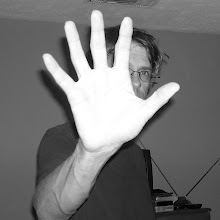
Chapter 3 – The Elephant Man: This is a great chapter in that it shows how Lynch navigated the delicate path from being an obscure, somewhat inexperienced director to taking charge of a big Hollywood production. There are interesting bits about Anthony Hopkins’ and Sir John Gielgud’s reactions to Lynch and a fascinating description of Lynch’s failed effort to personally design the Elephant Man make-up: “the young director understood that his design just wasn’t good enough, and he manfully turned the project over to makeup technician Christopher Tucker.” (p. 109) Good stuff!
Chapter 2 – Eraserhead: A masterful examination of one of Lynch’s best works. I found myself re-watching parts of the film as I read through the chapter. Olson provides a keen analysis of Henry’s journey and in particular the film’s denouement. Despite a thorough and convincing argument, however, I found myself disagreeing with some of his conclusions. Olson maintains that by killing his baby, Henry finds transcendence and an ultimately happy existence with the Lady in the Radiator:
The circle of Henry’s journey has closed. His tortuous quest for a home that will shelter and inspire his emotions and spirit has been fulfilled. His love for the Lady in the Radiator has stirred him from benumbed confusion and despair to action. In terms of Lynch’s all-time favorite film, The Wizard of Oz, Henry has made it ‘over the rainbow.’ He only had to kill his child to get there. (p. 83)
Some might argue that the end presents Henry as having achieved some sort of transcendent existence. Interestingly, the final shot in the film is a close-up of his face, and his eyes are closed. […] The scene is reminiscent of the conclusion of Fire Walk With Me, in which Laura Palmer, having just died, meets her angel, and white light floods the screen. Cooper is by her side, and she is smiling. Clearly she is in some sort of heaven.
Yet notice that her eyes are open, whereas Henry's are not. Is he sleeping, or do the closed eyes represent his death? […] Unlike Laura, whose eyes are open because she finally sees the big picture about life and her purpose in it, Henry has fled from his responsibilities, preferring the company of the Lady in the Radiator. As such, although he is not experiencing fear at the moment, he is still trapped by it. Henry does not see the "whole thing," so he has not truly escaped from his fear. (WIP 65)
Despite my disagreement, Olson’s arguments are persuasive and meticulously researched. He proves that there is no one “right” interpretation of Lynch’s films. This is film criticism at its finest.
Chapter 1 – The Alphabet and The Grandmother: A wonderful introductory chapter that sheds much light on the early years of Lynch’s life. Olson provides what most other Lynch writers have missed—a strong biographical background of David Lynch. In the chapter we learn much about Lynch’s youth and how he became interested in painting and ultimately film. Olson delivers in-depth analysis of Lynch’s early works, particularly The Alphabet and The Grandmother. Again, I found myself going back to watch these films after I read Olson’s analysis.
After reading the first four chapters of Beautiful Dark it is clear that Olson has set his sights extremely high. The book is not simply a biography, or a behind-the-scenes look at movie-making, or a critical study—it’s all three at once! I look forward to the next chapter!



Great blog
ReplyDeleteThumbs up. I'm impressed with some brief thoughts that you wrote after reading David Lynch: Beautiful Dark book. I'm looking forward to reading this book although the price of this book is extremely high.
ReplyDeleteAfter reading your article I became increasingly interested in having this book. I've read this book but unfortunately only up to chapter 3. I'm curious to read the next chapter.
ReplyDeleteNice post love reading it
ReplyDeleteleather pants for men
Skin Tight Leather Pant
Straight Fit Leather Pant